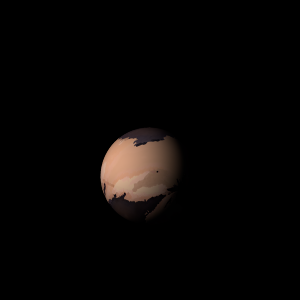|
|
Space Astro
|
Info for exoplanet "Lixesu"
| Scientific (actual) data |
|---|
| Name | Kepler-660 b |
| Planet status | Confirmed |
| Radius | 0.229 |
| Orbital period | 9.27358 |
| Discovered | 2016 |
| Updated | 2021-02-05 |
| Tconj | 2455010 |
| Publication | Announced on a website |
| Detection type | Primary Transit |
| Alternate names | 2MASS J19123318+4743280 b, K00746.01, KIC 10526549 b, KOI-746 b, KOI-746.01, WISE J191233.18+474328.3 b |
| Star name | Kepler-660 |
| Right ascension | 288.14° |
| Declination | 47.72° |
| Mag j | 13.672 |
| Mag h | 13.12 |
| Mag k | 13.033 |
| Star distance | 564 |
| Star metallicity | -0.07 |
| Star mass | 0.75 |
| Star radius | 0.71 |
| Star age | 4.57 |
| Star temperature | 4779 |
| Star alternate names | 2MASS J19123318+4743280, KIC 10526549, KOI-746, WISE J191233.18+474328.3 |
| Wikipedia article | Kepler-660 b |
Back
| |
| Fictional info (?) |
|---|
| Suggested name | Lixesu |
| Planet type | Cold planet |
| As seen from Kepler-660, in a frame of reference that rotates with the orbital motion, it appears to rotate only once every two years.
The largest moon, Soqi, has a diameter greater than that of the planet Jupiter. |
| Atmosphere | Carbon monoxide | 49% |
| Nitric oxide | 33% |
| 2H2O | 15% |
| Methane | 0.79% |
| Sulfur dioxide | 0.78% |
| Krypton | 0.54% |
| Helium | 0.36% |
| Atmospheric pressure | 0.008 bar |
 |
| Moon | Soqi | Huge potato shaped rocky moon |
| Ivuxeleg | Medium-sized round rocky asteroid |
| Ugupyvo | Small round oceanic planetoid |
| Elisi'c | Medium-sized potato shaped ice moon |
| Google search for Lixesu |
|
Website by Joachim Michaelis
|
|
|
|